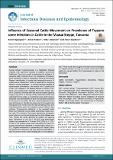| dc.contributor.author | Ngongolo, Kelvin | |
| dc.contributor.author | Estes, Anna B. | |
| dc.contributor.author | Hudson, Peter J. | |
| dc.contributor.author | Gwakisa, Paul S. | |
| dc.date.accessioned | 2021-02-11T06:17:43Z | |
| dc.date.available | 2021-02-11T06:17:43Z | |
| dc.date.issued | 2019 | |
| dc.identifier.uri | https://doi.org/10.23937/2474-3658/1510079 | |
| dc.identifier.uri | https://dspace.nm-aist.ac.tz/handle/20.500.12479/1106 | |
| dc.description | This research article published by the Journal of Infectious Diseases and Epidemiology, 2019 | en_US |
| dc.description.abstract | Animal African Trypanosomosis is a Neglected Tropical Disease with significant impacts to pastoral community livelihoods. Our study sought to determine the influence of seasonal cattle movements on the prevalence of trypanosome infections in cattle in the pastoral areas of the Maasai Steppe. Identification of spatial and temporal dynamics of trypanosome infections in cattle is essential for designing effective control strategies. To identify potential hotspots of trypanosome transmission, we worked with 5 pastoralists in each of 3 villages in the Maasai Steppe of northern Tanzania, and consecutively sampled 10 of each of their cattle in 3 periods, covering both wet and dry season grazing ranges (July 2017 to January 2018). Each time blood was collected from the cattle, a prophylactic dose of diminazene aceturate was administered to clear any parasites acquired in the previous 3 months. We then used participatory mapping techniques to identify the areas where the pastoralists had grazed their herds since the last sampling period, and interviewed them about any disease control methods they practice. Trypanosome infections in the sampled cattle blood were detected using nested polymerase chain reaction with ITS-1 primers. The overall prevalence of trypanosome infections across all sample periods and villages was 12%, though this varied distinctly by season and grazing area. Prevalence in July 2017 (19.33%) was significantly higher than prevalence in October 2017 (2%) (p < 0.05). A total of 45 grazing areas were identified and cattle acquired trypanosome infections in almost half of these (n = 21). Targeted awareness on seasonality and hotspot areas of trypanosome infections will help Maasai pastoralists to plan movement of their cattle strategically to avoid disease risk. These results also suggest enhanced control strategies for Trypanosomosis during the months of the year when cattle are moved further from homesteads to graze in hot spot areas. | en_US |
| dc.language.iso | en | en_US |
| dc.publisher | Journal of Infectious Diseases and Epidemiology | en_US |
| dc.subject | Cattle movement | en_US |
| dc.subject | Trypanosome prevalence | en_US |
| dc.subject | Maasai steppe | en_US |
| dc.title | Influence of Seasonal Cattle Movement on Prevalence of Trypanosome Infections in Cattle in the Maasai Steppe, Tanzania | en_US |
| dc.type | Article | en_US |

